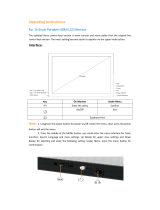
1–4 Software Guide
Power
Hibernation is enabled by default, but can be disabled (usually,
to save space on the hard drive).
Ä
CAUTION: Disabling Hibernation is not recommended. When
Hibernation is disabled, system-initiated Hibernation cannot save your
work if the tablet PC reaches a critical low-battery condition while it is
on or in Standby.
To verify that Hibernation is enabled:
» Select Start > Control Panel > Performance and Maintenance
icon > Power Options icon > Hibernate tab.
If Hibernation is enabled, the Enable Hibernation check box is
selected.
Choosing Standby, Hibernation or
Shutdown
When You Leave Your Work
If you plan to resume shortly: Initiating Standby clears the screen,
uses less power than leaving the tablet PC on, and your work
returns quickly to the screen when you resume from Standby. A
battery pack that has been frequently charged and discharged will
support Standby for less time.
If you plan to resume within 2 weeks: Initiating Hibernation clears
the screen, saves your work to the hard drive, and uses much less
power than Standby. Returning to work saved in Hibernation
takes longer than returning to work saved in Standby, but is faster
than returning to your place manually after restarting the
tablet PC.
If the tablet PC will be disconnected from external power for
more than one month: Shutting down the tablet PC and removing
the battery pack extends the useful life of the battery pack.
Store the battery pack in a cool, dry place. For more battery pack
storage information, refer on this CD to the Hardware Guide,
“Battery Packs” chapter, “Storing a Battery Pack.”
334243-001.book Page 4 Friday, August 15, 2003 10:22 AM




















